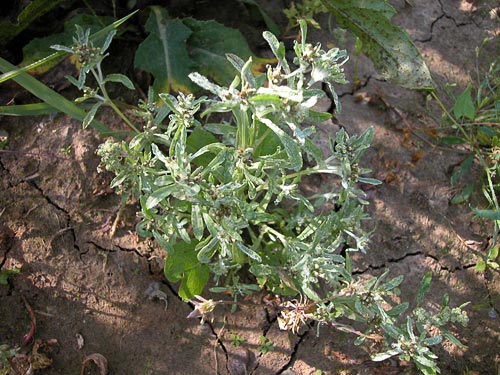Weeds
Gnaphalium uliginosum L. - Marsh Cudweed, Low Cudweed.
Systematic position.
Family Asteraceae, genus Gnaphalium L.Synonym.
Filaginella uliginosa (L.) Opiz.Biological group.
Spring annual weed.Morphology and biology.
The plant is 5-20 cm tall, with short roots (5-18 cm). It is covered with tufted white tomentum, especially above, at anthodia. Stalk more or less branchy from the base. Leaves are linear-oblong or lanceolate, pointed, narrowed at base, petiolate, frequently crescent, entire. Anthodia 3-4 mm long and 3-3.5 mm wide, gathered at ends of branches in glumes in groups of 2-4, less often single, located in axilla of convergent upper leaves exceeding anthodia; external leaflets of involucre are ovoid, blunt, somewhat woolly at base; internal ones are pointed, bare, green, later brownish or brown, shining. Marginal flowers are pistillate, threadlike; median flowers are bisexual, tubular; receptacle bare, cellular. Pappus is formed of falling breakable hairs. Hemicarp is greenish-gray or light brown, oblong, 0.5 mm long and 0.15-0.2 mm wide, slightly flattened, with narrow short apical rostrum having appreciable ring torulus. Hemicarps sprout well in damp ground during summer. Germinating capacity of seeds is maintained for about 5 years. Blossoming occurs during the second half of June until August. One plant produces 100 to 500 hemicarps; weight of 1000 seeds is 0.007 g.Distribution.
The European part of the former Soviet Union, the Caucasus, all of Siberia, Western Europe except Arctic regions, Northern America, Japan, Korea, Manchuria, Mongolia.Ecology.
This is a plant of damp habitats, growing in marshy places, along banks of rivers and lakes, in damp meadows, drained bogs, on soils of various mechanical structures. As a weed it occurs near drains, along roads, on fallows, and in crops.Economic significance.
Weed of grain crops, mainly of winter cereals, having an occurrence of not more than 10-20% and abundance of 2-3 points, found less often among tilled crops and flax. Control measures include treatment of fallows, autumn plowing, weeding, crop rotation; application of herbicides, if necessary.Reference citations:
Keller B.A., ed. 1935. Weed plants of the USSR. V. 4. Moscow-Leningrad: AN SSSR. 416 p. (In Russian)Nikitin, V.V. 1983. Weeds in the flora of the USSR. Leningrad: Nauka. 454 p. (In Russian)
Samersov V.F., Padenov K.P., Soroka S.V. 2000. Weediness of crops in Byelorussia and methods of its reduction. Zashchita i karantin rastenii, 3: 20-22. (In Russian)


